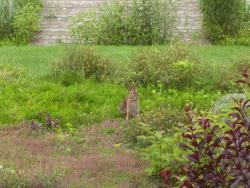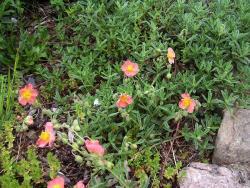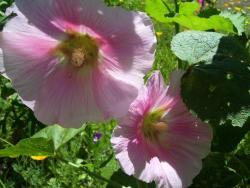After the warmest February and the coldest April on record, the Canada geese are behaving oddly. By now (late May), we are usually playing host to three or four pairs of geese that have nested near our pond and hatched goslings. Instead, we have more than seven pairs of geese on the pond and no nesting activity. One pair that arrived ahead of schedule did nest, very early, but lost their eggs to predators and didn't bother to try again. I suspect that this year many geese were unable to nest successfully because of unseasonable cold and lack of food. During April, snow and ice repeatedly covered up the grass (including a two-day storm that dropped three inches of ice pellets in the middle of the month), and the pond froze-over four times. The last snowfall was April 28.
The other strange thing that the geese are doing is perching. Normally, when two males have a territorial spat, the loser will fly off and land on water. This year, the losers are flying upwards and landing on our roof. I suppose, without flightless goslings to protect, they don't need to stay low. Anyhow, the "thud" of a goose landing on the roof has become a familiar sound. Sometimes the victor follows the fleeing goose onto the roof, and then we can hear them running around up there. We just hope they aren't damaging the shingles.
A pair of geese with 8 goslings walked to the pond last week, but the parents didn't like the envious attention their offspring were getting from all our childless geese, and quickly went away again. The next day, we noticed a lone gosling paddling around with a single goose in tow. We think that the family of 8 got split up: the father went off with 7, and the mother stayed behind with one. This lone gosling seemed demented. It did not follow its mother, or any other goose for that matter, and zig-zagged around the pond as if it had a faulty guidance system. Out of the water, one minute it was happily pecking at blades of grass, and the next it was running full tilt in any direction that took its fancy. The poor mother goose looked worn out from trying to keep up with it. This state of affairs went on for several days until a childless pair of geese "adopted" both the single mother and the gosling. Now, the little one has two mothers herding it around and an adoptive father standing guard, and it has calmed-down.
I was watching the new family feeding on our lawn, and feeling a warm glow that things had worked out so well, when I noticed that the male goose was doing that head-bob that means he's about to take off. Sure enough, he flew, his mate flew, and then the mother goose flew after them leaving poor baby alone on the ground. My heart nearly stopped, but the gosling just ran for the water and in a moment its mother came back to find it. This urge to fly seems to happen to the adults at least once a day, but I no longer worry that the gosling will be permanently abandoned. Pretty soon the geese will begin their summer molt, and then they'll all be grounded.
By mid-August, my lawn grass is normally brown from a combination of heat and drought, but this has been a strange summer. There have been no dry spells at all, more wet days than dry ones, and few heat-waves. Some of the rains have been deluges, like the “100-year-storm” that arrived on my birthday in June and caused flash-floods, but mostly the precipitation has fallen as frequent showers and brief thunderstorms.
The outcome of all this moisture has been spectacular lawn color. I look out at my acres of grassy sward and think I’m in Ireland. The lawn is mowed weekly by an enterprising local couple who cut grass in summer and plow snow in winter. No guesses as to which season will make them the most money this year!
As a consequence of having a lush and weedy lawn, my best garden crop of 2017 is rabbits. At any time of day I can spot one, maybe two, cottontails nibbling or just sitting still and looking satisfied. The rabbits’ favorite spots are underneath the bird feeders, where the grass grows greener from bird poop fertilizer, and there is the added bonus of finding a fallen sunflower seed if the chipmunks haven’t beat them to it.
I am not sure how many rabbits are out there. We started the year with two adults – one wintered in the barn, the other under the deck – and then babies started to appear. There have been occasions when two baby bunnies were visible at once, so I know there are at least that many, but they all look fairly alike and I’m never sure if I’m seeing the same ones every day. They are doing a wonderful job of eating dandelions and other lawn weeds, and my flowerbeds are such an overgrown mess that I can’t tell what else is ending up inside the rabbits. I’m just enjoying the sight of them hopping around.


I suspect that the rabbits spend as much time watching me as I spend watching them, because they certainly know that I can’t move very fast and they have nothing to fear from me. When I stumble from the house at dawn, to fill up the bird feeders, the rabbits ignore me and I have to detour around them.
The ultimate beneficiary of all this bunny abundance will be the foxes and coyotes. By next spring, we will probably only have two rabbits again.


The high-pitched “eeeee” sound was unmistakable. It brought me out of sleep and had me sitting bolt upright in bed at 1 a.m., one recent morning. My DH mumbled, “Whassamatter?” and I replied, “A mosquito just flew past my ear.” Because his hand-eye coordination is better than mine, DH then had the task of hunting down and killing the insect, while I wandered around the room as bait. It bit me once on each shoulder before it was dispatched.
I was in my 20’s before I discovered that mosquitoes liked me. Up to that time I had lived in England and encountered only harmless gnats and midges. The first intimation of trouble ahead came on a trip to Italy with a friend. Novice travelers, we didn’t know to avoid Italy in August, and we found the cities stiflingly hot and full of mosquitoes. I was bitten, and bitten, and bitten, while the insects unfairly ignored my friend.
One disastrous visit to a Caribbean island, when I sustained 23 mosquito bites to my legs in one evening, convinced me I should not travel to the tropics. Other vacations abroad took me to mountains, deserts, and breezy places with minimal biting-insect activity, although if there was a mosquito anywhere in the vicinity, I was its target, and all my hotel rooms magically contained a mosquito even if I had not opened a window.
In the fall of 1982 I emigrated from England to Ontario, Canada. I arrived when the weather was beginning to be frosty, and by the time the long winter ended I was eager to go out and explore the parklands in Toronto’s ravines. I remember standing in a delightful woodland clearing, seeing an insect alight on my arm, and thinking, “What a big gnat!” and then, “Ow!”
So began a long battle to deter the so-called “Provincial bird of Ontario” from biting me. I declined all invitations to go camping. I stayed away from woods, lakes, swamps, and rivers. I covered myself in insect repellent when gardening. This strategy worked until DH and I retired. We moved to a wooded property containing a large pond, a wetland, and a stream, and I slathered “Off” insect repellent lotion onto myself so often that my skin developed an allergic reaction to DEET. I purchased bug-net headgear and resigned myself to seeing my garden through a film of netting from spring to fall.
Over the years, through trial and error, I found a DEET-free, herbal, insect repellent that worked. The only drawback was that it smelled like rotting lemons and repelled people as well as mosquitoes. Matters were taken out of my hands when a regulation came into effect out-lawing the sale of herbal concoctions that had not undergone exhaustive and expensive laboratory testing, and ‘Buzz Away’ suddenly became unavailable. Shortly thereafter I headed to Europe for another vacation, and during a layover at Heathrow airport I decided to look for insect repellent in the Duty Free stores. I found a selection of DEET-free lotions, and I bought a tube of Boots pharmacy’s lightly fragranced ‘Repel’ to test against Tuscan insect vampires. ‘Repel’ turned out to be perfect: non-smelly and very effective. Every time I travel through Heathrow airport, I buy more tubes of it.
When all the geese stopped feeding and stood still, with their heads up and pointing in the same direction, I knew something was up. They weren’t making any noise or moving towards the water, so it wasn’t a predator they were staring at, but I was curious to know what had caught their attention. It takes a lot to make a Canada goose stop eating.
I moved closer to the window and peered out. There! On the grassy sward in front of the garden shed a strange event was playing out. A large and glossy crow and a plump wild rabbit confronted each other. The crow repeatedly yelled at the rabbit, using three or four well-spaced, consecutive caws like the call that crows use to keep in contact with the other members of their family group. However, I could not hear any other crows responding. The crow made darting, pecking motions towards the rabbit, and then the rabbit made an aggressive dash towards the crow. The crow leaped into the air and launched an aerial attack, causing the rabbit to back away. This scenario played out four or five times, until the rabbit had backed all the way into some tall grass. Once the rabbit was hidden the crow seemed to feel that its job was done, and after strutting and yelling for a moment longer, it took off.
Interspecies aggression between creatures that are not normally enemies or competitors is puzzling. What could cause it? Perhaps the crow had hidden a cache of corn in the grass near where the rabbit was grazing, but would a crow attack an animal larger than itself in order to keep its cache intact, especially when there was plenty of food around? Would the rabbit have been annoyed that the crow was making a lot of attention-getting noise while it was quietly grazing? Could the crow have been staging a display of dominance and bravery to impress the others of its group, or a potential mate, while shouting, “Look at me!”? Small dramas of the natural world play out around us all the time, but we rarely glimpse them, and struggle to understand them. What must it be like to be a rabbit, totally alone in the world and constantly in peril from hawks, foxes, and coyotes? Or to be a crow, bound by strong social ties to a group with a pecking order?
This summer is the hottest and driest I can remember. Other parts of the Province have been lucky with showers and thunderstorms, but here hardly any rain has fallen for months. The lawn is a parched brown expanse dotted with plantains, thistles, and a yellow-flowered leguminous weed that seems to be indestructible. The flowerbeds are filled with distinctly unhappy, stunted, and wilting perennials. Shrubs and trees are dotted with dead leaves. It’s a real stress test for the garden.
I’m glad that when I planted the flowerbeds I included a number of marginally-hardy items that are adapted to long, hot, dry summers. Saint Bernard’s Lily (Anthericum lilago) is one. It has grassy foliage, produces clouds of tiny white flowers, and self-seeds mildly.

Rock Roses are handling the drought well. In my gravel-mulched alpine bed I planted in full sun a slew of named Helianthemum nummularium cultivars with white, pink, orange, red, and yellow flowers. Winters and deer took their toll of the original plants, and I now have just white, red, and a self-seeded coppery-pink.

Glaucium flavum, a biennial or sometimes perennial poppy, survives next to a south-facing house wall where it receives little water, and there are always seedlings to replace plants that die after flowering.

I realized that Hollyhocks were drought-tolerant when I saw them growing in arid conditions in central Turkey. Hollyhocks were already in my present garden when I arrived, but over the years they have changed from tall, bright pink specimens growing in deep soil into short plants flowering in shades of pale pink seeded into the gravel driveway. As they are half normal height, I call them Hobbit-hocks.

Many people would not think of foxgloves as being resistant to drought, and indeed the large-leaved biennials are not. Fortunately there are a bunch of perennial Mediterranean and alpine species that can handle full sun and dry conditions. Pink-flowered Digitalis thapsi is alas not hardy for me, and Digitalis lanata, the woolly foxglove, only lasted a few years in Zone 4, but a mixed bunch of yellows and tans have not only proved themselves hardy, they lap up full sun and seem impervious to drought. I planted Digitalis ambigua, D. dubia, D. ferruginia, D. grandiflora, D. ‘John Innes’, and D. parviflora. They have crossed themselves so many times I have no clue what they are any more, but every year there are more of them.

So, even though the hot, dry weather is relentless and many plants are dying, my garden is sure to have some survivors.